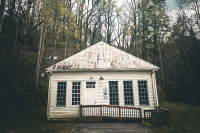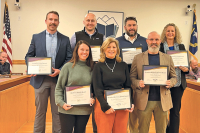Play me that mountain music: Carroll Best and The White Oak String Band
 French Kirkpatrick can sum up Carroll Best.
French Kirkpatrick can sum up Carroll Best.
“What he did with the banjo was above and beyond,” Kirkpatrick said. “He was the most, probably without a doubt, the most creative banjo player I was ever in a room with.”
Recently at his home in Ironduff, a mountain community a few miles outside of downtown Waynesville, Kirkpatrick, an acclaimed musician in his own right, relaxed further back into his couch and reminisced with a smile about his late friend.
“When you hear somebody put a string of notes together that just keeps rolling, and he just keeps rolling — it was amazing,” the 75-year-old said. “[Carroll] was not restricted to one style of music. It was phenomenal what he did on a banjo.”
Regarded as one of the all-time great and influential banjoists, Best, a Haywood County native, was known for his signature “fiddle style,” which was a melodic, syncopated three-finger stroke he evolved and perfected. That specific style of playing allowed Best the capability to perform a wide-array of songs by following fiddle tunes note for note.
“Carroll was a gifted, regional banjo player who influenced national musicians. He was among the first, if not the very first banjo player to move three-finger hillbilly ‘pickin’ toward jazz and melodic melodies requiring a sophisticated ear and independent dexterity given only to few,” said Marc Pruett, Grammy Award-winning banjoist of Balsam Range and Haywood County native. “He farmed, he worked in the local mill for years, and to those of us lucky enough to have known him, he freely shared his music.”
Related Items
And that unique sound echoing from Best’s fingertips was captured on a reel-to-reel tape by storied “song catcher” Joseph S. Hall. During two recording sessions in 1956 and 1959, Hall gathered a handful of Haywood pickers, including Best and Kirkpatrick, to sit around a living room and simply play the melodies they knew and loved.
Some of the recordings were kept in Hall’s personal and extensive archives, while others were sent directly to the Library of Congress in Washington, D.C., for posterity and as a historical record of Southern Appalachian culture.
Those tapes were recently dusted off by Dr. Ted Olson, professor of Appalachian studies at Eastern Tennessee State University in Johnson City, Tenn. Alongside the Great Smoky Mountains Association, a nonprofit preserving the culture of Southern Appalachia, Olson has now released a 37-song collection of the Hall recordings with the album “Carroll Best and The White Oak String Band, Old-Time Bluegrass from the Great Smoky Mountains, 1956 and 1959.”
SEE ALSO: Liner notes from "Carroll Best and The White Oak String Band"
SEE ALSO: The boy from Laurel Branch: An Interview with French Kirkpatrick
“The Smokies could not have found a better friend for preserving their history than with Hall,” Olson said. “The Smokies have always had such a rich and beloved music history, and were one of the least understood regions of music in the Appalachians, and the Hall recordings have brought such appreciation to the music of this area.”
The official release party for the record will be Sept. 19 at Lake Junaluska.
“Entering into the 21st century, things are changing so quickly, technologically and socially, so people want to understand where they came from, and Hall’s recordings provide a real window to the past,” Olson said. “To witness other people get reconnected to their family members and their stories, to bring this musical heritage to a new generation has been really gratifying.”
“When people look back at what was happening [with these recordings], they will see a major link between the [old-time] Appalachian music and how it ties into the bluegrass music that came out of Kentucky,” Kirkpatrick added. “These guys were not copying Earl Scruggs or Don Reno’s versions, these guys wanted to make their own sound.”
Who was the ‘Song Catcher?’
In 1937, Californian Joseph S. Hall was a 30-year-old graduate student. Hired by the National Park Service for a summer job, Hall was commissioned to seek out and capture the essence of the unique people, places and things amid the high peaks and hollers of the Great Smokies.
With notepad in-hand, he jumped into a pickup truck and headed into the isolated landscape, coming out with innumerable pages of stories told in a unique dialect — one that evolved partly out of the Scots-Irish and German ancestry of mountain settlers, and partly, it seemed, from the mountains themselves.
“He loved his work, and the mountain people loved him,” said Steve Kemp, interpretive products and service director for the GSMA. “He spent months in the work camps, at people’s houses, in the fields, at church and funerals. He immersed himself in the culture.”
These people he interviewed had a variety of distinct accents and created beautiful music, things that ink and paper couldn’t do justice. He knew he had to come back, and did in 1939. Gathering up his primitive recording equipment (which included phonograph cylinders), Hall set out again for the Great Smoky Mountains, this time to be a fly on the wall, simply letting the music play and speak for itself.
Those initial recordings were held at the Library of Congress, with the GSMA compiling them into the album “Old-Time Smoky Mountain Music.” That record went on to receive a Grammy Award nomination for “Best Historical Album” in 2012. And with the success of the first release, Olson, the Hall estate and GSMA decided to dig a little deeper and see what other treasures were waiting to be discovered in Hall’s archives.
Thus, the tapes of Carroll Best and The White Oak String Band bubbled to the surface.
“Hall’s materials are so rich, valuable and carefully preserved, even though the tapes weren’t widely known they existed by even some of the families and communities in which he recorded,” Olson said. “It’s a bit of a treasure hunt, [where Hall] balances a sense of awe and respect with what continues to be a fair and empathetic representation of the Smokies.”
The ‘Song Catcher’ returns
After his trips to the Smokies throughout the 1930s, Hall became utterly fascinated with the mountains and its people. He never forgot the remarkable people and lifelong friendships he forged, many of which he nurtured until his death in 1992 at age 85. He cherished his time in Southern Appalachia, with several trips over the decades, as a NPS employee or freelance researcher, aimed at recording as much of the culture as the tapes could contain.
On July 21 and Aug. 5, 1956 and July 22, 1959, Hall hauled his recording equipment to the home of Teague Williams (brother-in-law to Best) in the Upper White Oak community on the edge of Haywood County, just outside the boundary of the Great Smoky Mountains National Park. It is thought Hall knew Williams from his travels around the mountains during the 1930s recording sessions.
“Teague set up the sessions, brought Hall in to make the recordings, and called up the musicians to come and play,” Olson said. “There really was an atmosphere of trust between Hall and Williams and Williams with the local musicians.”
A seemingly “honorary Appalachian,” Hall found himself consistently in the good graces of mountain folk, something felt by a young French Kirkpatrick, who was just a teenager when he first met Hall.
“I remember [Hall] had a good demeanor about him, he wasn’t a know-it-all person, he just wanted to do a good job,” he said. “He was a real pleasant, easy going person, he would make you feel like he was your uncle.”
“[Hall] was deeply respected and loved,” Olson added. “He gained a deep sense of trust with the families in the Smokies, he earned it and maintained it over the years.”
Within the July 21, 1956, session, one can hear the heavenly sounds of Carroll Best and The White Oak String Band. Only 25 years old at the time, Best played alongside 27-year-old fiddler/rhythm guitarist S.T. Swinger and another guitarist simply noted as “Joyce.” Best’s new bride, 18-year-old Louise, also joined in on the recording, ultimately singing on a couple of ballads. During the Aug. 5, 1956, session, Best and Swanger were joined by 24-year-old rhythm guitarist Don Brooks and also Williams, who jumped on the microphone for “More Pretty Girls Than One.”
 Title
Title
Title
Title
 Title
Title
Title
Title
 Title
Title
Title
Title
 Title
Title
Title
Title
 Title
Title
Title
Title
 Title
Title
Title
Title
 Title
Title
Title
Title
 Title
Title
Title
Title
 Title
Title
Title
Title
https://smokymountainnews.com/archives/item/14174-play-me-that-mountain-music-carroll-best-and-the-white-oak-string-band#sigProIdf003d9e8a3
Lightning strikes twice
In 1959, Hall returned to the Smokies for another round of music recordings at the Williams’ household. This time, Best was joined by 36-year-old singer/guitarist Raymond Setzer, 26-year-old fiddler Billy Kirkpatrick and his 20-year-old brother, French, who played rhythm guitar on the July 22 session.
“Back in those days, we played every Friday and Saturday night at somebody’s house, and it might as well have been at Teague Williams’ recording as anywhere else,” French said.
And so, Williams got hold of the boys on the party line (multiple household phone line) on July 22, telling them to get down to his house to record with Hall.
“[Hall] had this humungous reel-to-reel recorder, and I thought, ‘my goodness, what’s this guy going to do with this,’” French chuckled. “He told us he’d put the music in the Library of Congress and I really didn’t think much of it.”
French noted that one has to put things in the perspective of 1950s Appalachia when it came to the out-of-this-world notion that the sounds of he and his musician friends would end up in the national archives.
“You’ve got to think back to the 1950s. There was not many televisions around then and the records you got were 78 rpms,” French said. “I mean for somebody to want to record you on a reel-to-reel recorder and put it in the Library of Congress of the United States, well, that was big stuff, man.”
Listening to the recordings, one can hear not only the youthful exuberance of the band, but also the foundation of lifelong melodic talents, especially through the hands of Best, whose banjo cascaded up and down the fret board with such style and grace.
“To hear Carroll Best, he really went on to reinvent himself and take his music to another level,” French said. “He was never comfortable to say ‘I’ve got this,’ he always tried to make the next time better than he did the last time and that’s what really identifies a good musician.”
Following the recording sessions, the members of The White Oak String Band continued to play for a time before going their separate ways. Each continued performing throughout their lives. Over the years they would cross paths, jamming together again.
At the center of it all was Carroll Best, who went on to have a somewhat successful music career. Though many feel, even today, he never got the credit or success he deserved, those in the know, including banjo legends Tony Trischka and Bela Fleck, point to Best as an immediate influence on not only them, but also the evolution of the banjo sound itself.
“This is an extremely important album for banjo players, and really for anyone with an interest in historically significant old-time, country and bluegrass music,” Trischka said of the new album. “Carroll Best single-handedly created a unique banjo style that allowed one to play fiddle tunes note for note. He could also burn in a more Scruggsy sort of way, as these recordings will bear out.”
Throughout his life, Best played all around the Southern Appalachia region, winning banjos competitions, ultimately pushing his reputation as one of the finest pickers further into the industry-at-large. Sadly, on May 8, 1995, Best was murdered by his brother, Sam. Though his life extended 64 years, Carroll’s influence will seemingly live on forever in the hearts of this who continually discover and rediscover his deep catalog of material.
The sound remains
It’s another sunny day in Appalachia as Louise Best gazes out onto the mountains of Haywood County from her porch nestled in the backwoods of the Crabtree community. When she got word about the 1956/1959 Hall recordings being found, remastered and released, she couldn’t believe it.
“I was surprised when [the GSMA and Olson] said they were going to do it because it was so long ago,” she smiled. “I knew that they were in the Library of Congress, but I just didn’t think about them redoing it.”
Of those recorded by Hall, only Louise, French and Raymond Setzer are still alive. And with that, Louise is proud of what her husband accomplished, as well as his influence on what he called “fiddle music.” What makes her even prouder is seeing her grandson, Jerry, pick up the banjo and play just like his “papaw” did. She looks at the new album as a way for future generations to appreciate and embrace their roots.
“Younger people can hear them, children can hear what their ancestors did,” she said.
And it’s not only children and young adults taking notice, the collection has also brought back memories of Best in the minds and hearts of some of Appalachia’s biggest names in music.
“Carroll Best was the ‘best,’” said Steve Sutton, the Grammy-nominated banjoist of Whitewater Bluegrass Company and Haywood County native. “We played together under a tree at Merlefest the evening before his death. It was tragic and such a loss in so many ways. [He made] the most beautiful sounds to ever come from a banjo. He showed me just how versatile the instrument could be — he was a one-of-a-kind.”
And though Best is physically gone from the earth, the sounds of his body, mind and soul echo deep into the history and backwoods of Southern Appalachia, a strong undertow in the vast, melodic ocean of mankind, one that will be felt for countless future generations. Even 19 years after his death, Pruett’s heart still holds a piece of Best in it.
“After a person is gone, their individual human history decays into little shards of memory in the minds of loved ones and friends,” he said. “As I close my eyes and remember Carroll, those shards of memory morph into sparkling music notes, diamonds almost. Then, I begin to hear a banjo rippling and pinging through cool night air at a Crabtree farm. And I see Carroll Best smile again, surrounded by family and friends he loved.”
Editor’s Note: Due to health concerns, Raymond Setzer opted to not be interviewed for this story.
Attend the release party
The Great Smoky Mountains Association will host a release party for the Joseph S. Hall collection “Carroll Best and The White Oak String Band” at 7 p.m. Friday, Sept. 19, in Stuart Auditorium at Lake Junaluska.
Those anticipated to be in attendance and to perform at the event include French Kirkpatrick and Raymond Setzer, the last two remaining original members of The White Oak String band, both of whom still reside in Haywood County; Carroll Best’s widow, Louise; as well as several Haywood County-area musicians inspired by Carroll Best, including Kirkpatrick’s band, The Unexpected; The Trantham Family, Rob & Anne Lough; The Randleman Brothers; and Laura Boosinger & Josh Goforth.
The record, “Carroll Best and the White Oak String Band, Old-Time Bluegrass from the Great Smoky Mountains, 1956 and 1959,” includes 37 songs and a 64-page booklet with photographs of the musicians, as well as extensive notes detailing their histories, their styles and the songs they played. The new album will be available for sale during the release party. It is now available for $14.95 at all park visitor centers, in local music stores or by contacting www.smokiesinformation.org or 888.898.9102 (x226).
Since its inception in 1953, Great Smoky Mountains Association has supported the preservation of Great Smoky Mountains National Park by promoting greater public understanding and appreciation through education, interpretation and research. A nonprofit organization, GSMA has provided more than $32 million to the park during its 60-year history.
Admission to the release party is free and open to the public.









